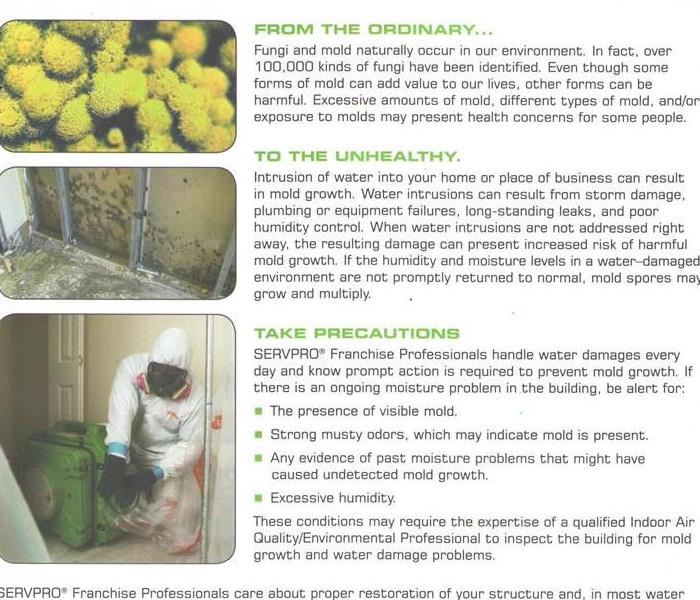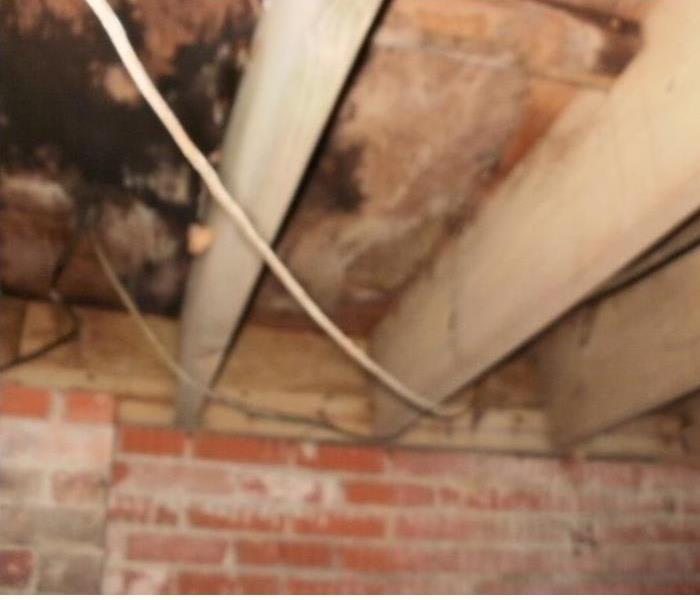Recent Mold Remediation Posts
Household Mold
6/25/2019 (Permalink)
 Tips for Mold
Tips for Mold
Aureobasidium is a mold that can sometimes be found growing behind wallpaper or on painted or wooden surfaces. Aureobasidium usually develops in a pink, brown or black color. As it ages, aureobasidium typically turns a darker brown color.
Aureobasidium spores are difficult to identify on spore traps because of morphologic variation. Its most distinguishing feature is the production of primary blastospores (spores produced by a budding process) arising directly from pigmented, vegetative hyphae on short denticles (protuberances in the hyphae). The spores may be hyaline or pigmented, variable in size, one-celled, ellipsoid or ovoid, and completely encased in a slimy coat. These primary spores can give rise to secondary or tertiary spores through yeast-like budding. The conidia (spores) adhere together to form slimy heads. The brown hyphae can differentiate to form chlamydospores (resting spores) or arthroconidia (asexual spores) at maturity.
When to Test?
- When visible mold is not present, but the smell of mold is, a mold inspection and mold test can reveal whether there is indeed elevated mold, and where it is located.
Types of Mold: Aureobasidium
7/2/2018 (Permalink)
Aureobasidium is an allergenic mold that can sometimes be found growing behind wallpaper or on painted or wooden surfaces. Aureobasidium usually develops in a pink, brown or black color. As it ages, aureobasidium typically turns a darker brown color.
Aureobasidium spores are difficult to identify on spore traps because of morphologic variation. Its most distinguishing feature is the production of primary blastospores (spores produced by a budding process) arising directly from pigmented, vegetative hyphae on short denticles (protuberances in the hyphae). The spores may be hyaline or pigmented, variable in size, one-celled, ellipsoid or ovoid, and completely encased in a slimy coat. These primary spores can give rise to secondary or tertiary spores through yeast-like budding. The conidia (spores) adhere together to form slimy heads. The brown hyphae can differentiate to form chlamydospores (resting spores) or arthroconidia (asexual spores) at maturity.
When to Test?
- When visible mold is not present, but the smell of mold is, a mold inspection and mold test can reveal whether there is indeed elevated mold, and where it is located.
- n some cases a doctor or the patient has a health issue that they cannot pinpoint the cause but seems to be related to mold symptoms (coughing, sneezing, headaches, etc). Here, a mold inspection and test may help to confirm whether the doctor’s or patient’s suspicions that a mold problem exists.
Household Mold Acremonium
6/29/2018 (Permalink)
ACREMONIUM:
Acremonium mold is a toxigenic mold type that evolves in its appearance over time. It first starts out as a small moist mold that turns into a fine powdery substance. Acremonium mold is often pink, grey, orange or white in color. Acremonium typically grows in household systems and areas such as condensation from humidifiers, cooling coils, drain pans and window sealants.
Acremonium is sometimes known to grow with other types of mold including strachybotrys, which creates a particularly unpleasant and dangerous mold problem in homes. Acremonium is a genus of fungus that consists of approximately 100 species. The presence of this slow-growing, prolific mold can be detected by its unpleasant stench in the air.
Tips to Control Mold
If you have leaks in the house or puddles of water in the basement, you can expect mold growth, and it can be difficult to eliminate. Make sure your house is well ventilated by opening windows or using a fan to keep air circulating. Immediately remove wet or water damaged articles such as rugs and upholstered furniture, and if the items cannot be thoroughly cleaned and dried, get rid of them.
Penicillium Mold
6/4/2018 (Permalink)
This type of house mold can be seen on walls, spoiled food, insulation, wallpaper and carpet. It is typically found around damp areas and near food that has gone bad. It typically appears in a blue or greenish color. The spores can cause allergic reactions but are not nearly as toxic as black mold. The discovery of penicillium helped aid the finding of penicillin which is used for treatment of bacterial infections. However, you do not want to have this type of mold in your home. It can easily be spread onto other areas of your home from trapped moisture. SERVPRO of Sumter offers free visual, non invasive mold inspections to help you determine the best ways to clean and treat any growth you may have.
The Basement Detective explains Crawl Space Mold
6/4/2018 (Permalink)
 A crawl space with noticeable growth in Sumter, SC
A crawl space with noticeable growth in Sumter, SC
The Basement Detective wrote an article about mold that we would like to share. It is as follows:
A moldy crawlspace is most often detected by technicians doing service work and by homeowners after noticing a hard to find musty smell in their homes. Locating mold in a crawlspace can be tricky due to a combination of low light and the presence of so many little nooks and crannies for the mold to hide.
Causes are near always attributed to water presence in some form or another. Whether moisture is pooling or condensing is often the concern in determining the source and location of any mold or moldy smells. It is the prevention and repair of the cause of these leaks that is the determining factor in preventing mold or moldy smells in the future. Simply placing plastic over the affected area will only give the moisture another substrate to condense on. This is why many crawlspaces that have been sealed without treating the water issues so often experience rotted wood corroded foundation walls and musty mold smells.






 24/7 Emergency Service
24/7 Emergency Service

